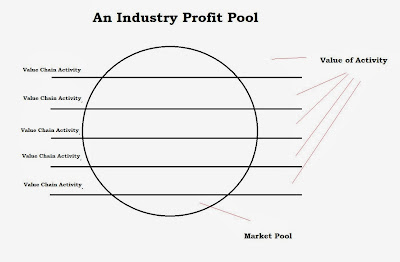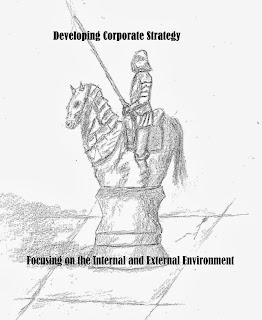Knowing in which market a business should compete
and the tasks needed to earn profit are necessary for sustainable growth. A
paper by Gadiesh and Gilbert (1998) helps strategic decision makers think about
their profit pools and how to earn sustainable profits. Some companies have declined because they
were trapped in drying pools and didn’t consider other possibilities in
creating new revenue streams.
Mapping a profit pool affords the opportunity to see
which activities are earning them revenue and which should be adjusted.
Furthermore, it also provides an opportunity to open the underlining industry
structure and determine which economic forces and pressures are impacting their
opportunities. To understand the environment creates greater opportunity for
strategic thinking.
Mapping the value pool is a process of outline the
value chain activities and then the potential profits of each. It is a process
of defining boundaries, estimating the pool’s size, value-chain profits, and
reconciling the calculations. Together these components should provide some
discussion on the possibilities available in the market for new businesses
opportunities.
Defining
the Pool: Defining a pool is helpful in determining what
segment of market a business should be working within. The first step is to
define this market for analysis. Understanding the boundaries of that market
will help in narrowing down which information will be relevant for analysis. Are
you in the banking business, fishing business, or telecommunications business?
Size
of Pool: The size of the pool is the total profits that can
be earned within a particular market. Analysts often look at industry reports
to determine the overall value of a market. At times it may be necessary to add
a number of industry statistics together if they fit within a firm’s market
pool. For example, a fish farm may find that there is a billion dollars (pool
size) total worth of fish activity within the area.
Value-Chain
Profits: Breaking the pool down into the profits made
through each value-chain activity can be difficult because financial
information may not be readily available. Using pure players to create
benchmarks and then estimating mixed players activity is beneficial. The goal is to break the profits of the
industry into varying activities such as fish farms, fishing vessels,
distribution, farmer markets, etc…
Reconciling
the Differences: Once you add up the distribution of value-chain
profits and know the total value of the industry they should roughly equally
the same size. If they do not come out
similar then the information used or the estimates may be wrong. It is
necessary to explore the differences to seek better information.
The benefit of outlining where profits can be earned
and made is to determine where new businesses can find their profits as well as
determining areas that have the potential to grow. Generally, the use of a pool
analysis will help companies determine new opportunities and change their
business strategies when their pool is declining. The overall process of
understanding the market and scanning the environment brings more knowledge and
information for decision-makers.
Gadiesh, O. & Gilbert, J.
(1998). How to map your industry’s profit pool. Harvard Business Review, 76 (3).


